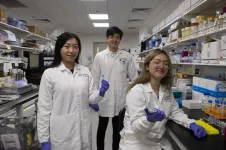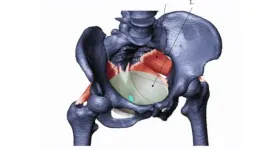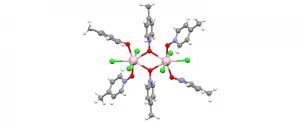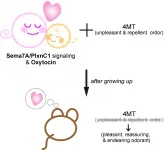(Press-News.org) The semiconductor industry and pretty much all of electronics today are dominated by silicon. In transistors, computer chips, and solar cells, silicon has been a standard component for decades. But all this may change soon, with gallium nitride (GaN) emerging as a powerful, even superior, alternative. While not very heard of, GaN semiconductors have been in the electronics market since 1990s and are often employed in power electronic devices due to their relatively larger bandgap than silicon--an aspect that makes it a better candidate for high-voltage and high-temperature applications. Moreover, current travels quicker through GaN, which ensures fewer switching losses during switching applications.
Not everything about GaN is perfect, however. While impurities are usually desirable in semiconductors, unwanted impurities can often degrade their performance. In GaN, impurities such as carbon atoms often lead to poorer switching performance due to trapping of charge carriers in "deep levels," energy levels created by the impurity defects in the GaN crystal layers and thought to originate from the presence of a carbon impurity on a nitrogen site.
A curious experimental manifestation of deep levels is the appearance of a long-lived yellow luminescence in the photoluminescence spectrum of GaN along with a long charge carrier recombination time reported by characterization techniques like time-resolved photoluminescence (TR-PL) and microwave photoconductivity decay (μ-PCD). However, the mechanism underlying this longevity is unclear.
In a recent study published in Journal of Applied Physics scientists from Japan explored the effect of deep levels on the yellow luminescence decay time and carrier recombination by observing how the TR-PL and μ-PCD signals changed with temperature. "Only after understanding the impacts of impurities in GaN power semiconductor devices can we push for the development of impurity control technologies in GaN crystal growth," says Prof. Masashi Kato from Nagoya Institute of Technology, Japan, who led the study.
The scientists prepared two samples of GaN layers grown on GaN substrates, one doped with silicon and the other with iron. The unintentional doping of carbon impurities happened during the silicon doping process. For the TR-PL measurements, the team recorded signals for temperatures up to 350°C while for μ-PCD up to 250°C due to system limitations. They used a 1 nanosecond-long UV laser pulse to excite the samples and measured the reflection of microwaves from the samples for μ-PCD.
The TR-PL signals for both samples showed a slower (decay) component with a decay time of 0.2-0.4 milliseconds. Additionally, the use of a long-pass filter with a cut-off at 461 nm confirmed that yellow light was involved. In both samples, and for both TR-PL and μ-PCD measurements, the decay time declined above 200°C, consistent with previous reports.
To explain these findings, the scientists resorted to numerical calculations, which revealed that the deep levels essentially trapped "holes" (absence of electrons) that eventually recombined with free electrons but took long to do so due to the extremely small chance of an electron being captured by the deep level. However, at high temperatures, the holes managed to escape from the trap and recombined with the electrons through a much faster recombination channel, explaining the decline in decay time.
"To reduce the effects of the slow decay component, we must either maintain a low carbon concentration or adopt device structures with suppressed hole injections," says Prof. Kato.
With these insights, it is perhaps only a matter of time before scientists figure out how to avoid these pitfalls. But with GaN's rise to power, will it be just better electronics?
Prof. Kato thinks otherwise. "GaN enables lower power losses in electronic devices and therefore saves energy. I think it can go a long way in mitigating greenhouse effects and climate change," he concludes optimistically. These findings on impurities may thus be what lead us to a cleaner, greener future!
INFORMATION:
About Nagoya Institute of Technology, Japan
Nagoya Institute of Technology (NITech) is a respected engineering institute located in Nagoya, Japan. Established in 1949, the university aims to create a better society by providing global education and conducting cutting-edge research in various fields of science and technology. To this end, NITech provides a nurturing environment for students, teachers, and academicians to help them convert scientific skills into practical applications. Having recently established new departments and the "Creative Engineering Program," a 6-year integrated undergraduate and graduate course, NITech strives to continually grow as a university. With a mission to "conduct education and research with pride and sincerity, in order to contribute to society," NITech actively undertakes a wide range of research from basic to applied science.
Website: https://www.nitech.ac.jp/eng/index.html
About Associate Professor Masashi Kato from Nagoya Institute of Technology, Japan
Dr. Masashi Kato graduated in Electrical and Computer Engineering from Nagoya Institute of Technology in 1998 and then proceeded to obtain both a Master's (2000) and a PhD (2003) in the same field there. He is currently an Associate Professor of Semiconductor Physics and has published over 70 papers in the course of his career. His field of expertise and research interests lie within electronic/electric materials and device-related chemistry, and he has been a member of The Japan Society of Applied Physics for nearly two decades.
For more information visit: http://researcher.nitech.ac.jp/html/30_en.html
People who have recovered from COVID-19, especially those with pre-existing cardiovascular conditions, may be at risk of developing blood clots due to a lingering and overactive immune response, according to a study led by Nanyang Technological University, Singapore (NTU) scientists.
The team of researchers, led by NTU Assistant Professor Christine Cheung, investigated the possible link between COVID-19 and an increased risk of blood clot formation, shedding new light on "long-haul COVID" - the name given to the medium- and long-term health consequences of COVID-19.
The findings may help to explain why some people who have recovered from COVID-19 exhibit symptoms of blood clotting complications after their initial recovery. In some cases, they are at increased risk of heart attack, ...
Evolutionary anthropologists from the University of Vienna and colleagues now present evidence for a different explanation, published in PNAS. A larger bony pelvic canal is disadvantageous for the pelvic floor's ability to support the fetus and the inner organs and predisposes to incontinence.
The human pelvis is simultaneously subject to obstetric selection, favoring a more spacious birth canal, and an opposing selective force that favors a smaller pelvic canal. Previous work of scientists from the University of Vienna has already led to a relatively good understanding of this evolutionary "trade-off" and how it results in the high rates of obstructed labor in modern humans. ...
They are diligently stoking thousands of bonfires on the ground close to their crops, but the French winemakers are fighting a losing battle. An above-average warm spell at the end of March has been followed by days of extreme frost, destroying the vines with losses amounting to 90 percent above average. The image of the struggle may well be the most depressingly beautiful illustration of the complexities and unpredictability of global climate warming. It is also an agricultural disaster from Bordeaux to Champagne.
It is the loss of the Arctic sea-ice due to climate warming that has, somewhat paradoxically, been implicated with severe cold and snowy mid-latitude winters.
"Climate change doesn't always manifest in the most ...
Altering a mosquito's gut genes to make them spread antimalarial genes to the next generation of their species shows promise as an approach to curb malaria, suggests a preliminary study published today in eLife.
The study is the latest in a series of steps toward using CRISPR-Cas9 gene-editing technology to make changes in mosquito genes that could reduce their ability to spread malaria. If further studies support this approach, it could provide a new way to reduce illnesses and deaths caused by malaria.
Growing mosquito resistance to pesticides, as well as malaria parasite resistance ...
Many consumers are willing to pay for improved environmental quality and thus non-market values of impacts of food production on e.g. water quality, C sequestration, biodiversity, pollution, erosion or GHG emissions may even be comparable to the market value of agricultural production. Diverfarming project elucidated how consumers value agroecosystem services enabled by diversification and provided consumer perspectives for developing future agricultural and food policies to better support cropping diversification.
The researchers quantified consumers' willingness to pay for the benefits of increased farm and regional scale diversity of cultivation practices and crop rotations. Three valuation scenarios were presented to a ...
Spain boasts the largest cultivated area of almond trees in the world, with more than 700,000 ha (MAPA, 2018), but ranks third in terms of production. How can this be? Actually it's easy to explain: most of the country's cultivated area of almond trees is comprised of traditional rainfed orchards and located in marginal areas featuring a low density of trees per hectare.
Over the last decade, however, the nut's surging prices havegiven rise to intensive almond tree plantations characterised bya high density of trees per hectare and the employment offertilisation and irrigation, yielding endless rows of white when the trees are in bloom. Knowing what the future of these plantations will be like in a ...
With summer around the corner, a project shows how implementing an evidence-based mindfulness program in a summer camp setting decreases emotional distress in school age children and empowers campers and counselors alike - enhancing camper-counselor relationships. Mindfulness - a state of consciousness that fosters awareness - has the potential to help regulate emotions and behaviors.
Researchers from Florida Atlantic University's Christine E. Lynn College of Nursing implemented an eight-week program guided by the Mindful Schools© curricula in a large urban summer day camp program (ages 3 to seventh grade). Mindfulness-based practices are intentional exercises ...
Light can be used to operate quantum information processing systems, e.g. quantum computers, quickly and efficiently. Researchers at Karlsruhe Institute of Technology (KIT) and Chimie ParisTech/CNRS have now significantly advanced the development of molecule-based materials suitable for use as light-addressable fundamental quantum units. As they report in the journal Nature Communications, they have demonstrated for the first time the possibility of addressing nuclear spin levels of a molecular complex of europium(III) rare-earth ions with light. (DOI: 10.1038/s41467-021-22383-x)
Whether in drug development, communication, or for climate forecasts: Processing information quickly and efficiently is crucial in many areas. It is currently done using digital computers, ...
Imprinting is a popularly known phenomenon, wherein certain animals and birds become fixated on sights and smells they see immediately after being born. In ducklings, this can be the first moving object, usually the mother duck. In migrating fish like salmon and trout, it is the smells they knew as neonates that guides them back to their home river as adults. How does this happen?
Exposure to environmental input during a critical period early in life is important for forming sensory maps and neural circuits in the brain. In mammals, early exposure to environmental inputs, as in the case of imprinting, is known to affect perception and social behavior later in life. Visual imprinting has ...
New research led by a professor at NUI Galway is set to change how doctors treat some patients with high blood pressure - a condition that affects more than one in four men and one in five women.
The study by researchers at NUI Galway, Johns Hopkins University and Harvard Medical School found no evidence that diastolic blood pressure - the bottom reading on a blood pressure test - can be harmful to patients when reduced to levels that were previously considered to be too low.
Lead researcher Bill McEvoy, Professor of Preventive Cardiology at NUI Galway and a Consultant Cardiologist at University Hospital Galway, said the findings have the potential to immediately influence ...








